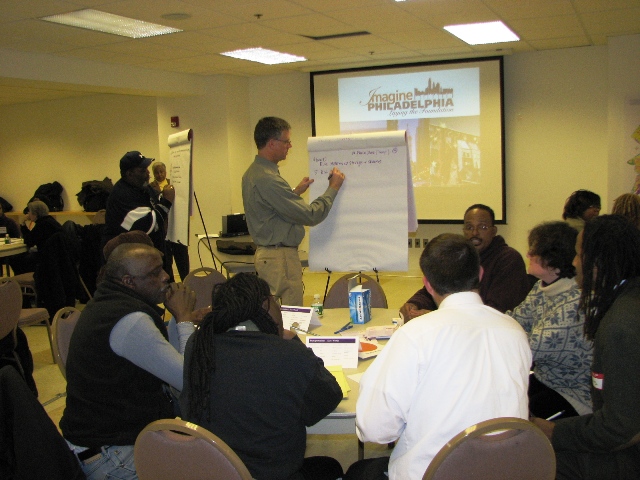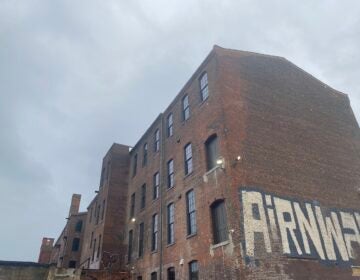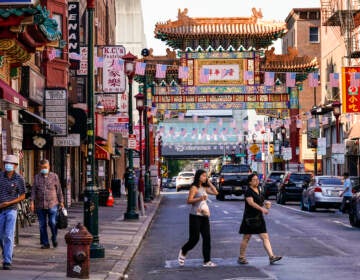Second phase of Imagine Philadelphia

The public engagement phase of the Imagine Philadelphia program hit its stride tonight with its largest turnout yet of neighborhood residents.
About 70 participants showed up at the fifth session of the City Planning Commission’s effort to rethink and update Philadelphia’s comprehensive plan. Tuesday night’s session was the first, however, under the new administration of Mayor Michael Nutter, and the first that was not presided over by Janice Woodcock, who had been the CPC executive director in the last year of the Street administration.
Instead, acting executive director Gary Jastrzab welcomed and invited his audience at the North Philadelphia Seventh Day Adventist Church, on Oxford Street off the Temple University campus, to offer their “big ideas” on how the city should develop over the next 35 years.
“This early work will contribute to a new comprehensive plan for Philadelphia,” said Alan Urek, the director of CPC’s strategic planning and policy division. Historically, the city was one of the first in the United States created with an urban plan – William Penn’s 1682 street grid. But the last “true comprehensive plan” was written back in 1960 under the guidance of planner Edmund Bacon.
It’s time for an update, Urek said.
The participants then began small-group discussions on the issues of open space and environment, economy, neighborhoods, public services and utilities, housing, transportation, culture and tourism, and regionalism.
While the city’s population has decreased since its peak in the 1950s, the metropolitan region has grown in population and development over two states and eight counties. A breakout group focusing on regionalism was asked to consider the city’s strengths and weaknesses in terms of its relationship with surrounding communities.
What has kept Philadelphia chugging along has been its central location on the East Coast, within easy range of New York and Washington, D.C., and other centers of trade, said Ryan Egan, an East Falls resident and special assistant to Councilman Frank Rizzo.
Robert Smith, a vice president of a North Philadelphia community development corporation, agreed that the city serves as a hub for the entire region.
The regional transit system is another great asset for the city, said Rashima Sonson, who moved to North Philadelphia from New Orleans following the devastation of Hurricane Katrina. “You don’t need a car here,” and that helps the environment as well, she said.
The regionalism team saw plenty of room for improvements, however. North Philadelphia resident Pat Kidd noted the rise of condominiums and housing in the city, but few examples of affordable housing development.
Sonson said the city should work harder to become a player in the global economy, and utilize its port to draw more international business to the region.
Smith focused on the tax breaks given to businesses in order to lure them to the city or suburbs. “What concerns me is the competition between the city and the municipalities around the city. They’re giving away the store just to get them here,” which puts the tax burden on longtime residents. He suggested that Philadelphia work cooperatively with its neighbors to limit the tax abatements offered to businesses.
Egan noted that the tax breaks are necessary to bring and keep the businesses in the city, which in turn keep jobs and people in Philadelphia. At the same time, he said, “the city wage tax is kind of outrageous.”
Businesses have fled from her North Philadelphia neighborhood, Kidd said, and have not been replaced. “The businesses are gone, the buildings have been torn down,” leaving vacant lots and no sign of redevelopment.
“The city has changed,” Smith said. “You only come to the city if you’re going to college, to a pharmaceutical industry, or the cable company.”
To improve regional relationships to everyone’s mutual benefit, the group offered several suggestions.
Sonson recommended business partnerships on the county level. Smith would like to see more interaction between municipal planning commissions.
But Egan noted the hostile attitude taken by many counties toward Philadelphia. “It’s hard to work with them,” he said.
If there was one thing they could improve for the sake of the region, the group members had other concrete suggestions.
Kidd said SEPTA could use some competition.
Egan noted that great cities have great waterfronts. “That’s what we’re lacking,” he said.
Smith returned to taxes. Instead of the current system of city taxes, “We should look at taxing regionally,” he proposed.
Four more community meetings are planned this month at sites around the city to collect public input on a variety of municipal topics.
The Planning Commission, with assistance from the consulting firm FXFOWLE, will then issue white papers in late summer or early fall based on the public sessions and expert recommendations.
WHYY is your source for fact-based, in-depth journalism and information. As a nonprofit organization, we rely on financial support from readers like you. Please give today.






